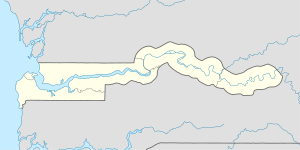| Location map of the Gambia Equirectangular projection. Geographic limits of the map: N: 14.3° N S: 12.6° N W: 17.0° W E: 13.6° W (Photo credit: Wikipedia) |
A sub-regional meeting in Banjul, The Gambia has open up to the revitalization of cross-border languages meant to reinforce interregional dialogue and promote access to universal knowledge in West Africa.
Organised by The Gambia’s Ministry of Basic and Secondary Education and the National Commission for UNESCO (NATCOM in Banjul), the March 7, 2013 meeting brought together language scholars from Mali, Senegal, Guinea Bissau and The Gambia.
Speaking at the meeting, Gambia’s Minister of Higher Education, Research, Science and Technology, Dr Momodou Tangara, said the initiative is relevant considering the challenges the sub-region is facing in regional integration, social disruptions and the conflict to fight against ignorance.
It is a common knowledge that Mali, Senegal, Guinea Bissau and The Gambia share a common culture and use many similar languages across their borders, Mr Tangara said.
| Deutsch: Arch 22, Triumphbogen in Banjul, Gambia zwischen dem Independance Drive und dem Banjul-Serekunda-Highway gelegen wurde am 22. Juli 1996 eingeweiht Español: Arco 22, en la entrada de Banjul (Photo credit: Wikipedia) |
He said the people across these borders are often faced with the same challenges and in pursuit of ways and means of addressing them, they find the need to adopt common responses.
“The language shared across the borders of these sub-regional countries plays a key role in the strategies of dealing with languages, hence, the need to promote and revitalize the commonly spoken languages in West Africa,” he said.
Historically, the use of common languages in the sub-region has ever been facilitating communication and dialogue within these countries.
But, Mr Tangara said the use of these national languages over the years “is being eroded, contaminated and distorted by foreign influences” because of people’s incapacity to promptly react to the aggressive terminologies and jargons.
“The non-actualization of our local languages poses the threat that restricts regional dialogue and limits access to universal knowledge,” the former foreign affairs minister said. “Due to the slow pace of the development and the official use of Africa’s languages, Africans largely rely on the two dominant world languages, English and French, to define concepts and conditions.”
How long can we continue along these lines, he asks, saying “if we as Africans are to harness the opportunism provided by national languages in our overall development agenda, the overdependence on foreign languages for our own survival has to be serious looked into.”
| Gambian woman and child. (Photo credit: Wikipedia) |
“Unfortunately, as stated in The Gambia Culture Policy, since independence, there have been only scattered and fleeting attempts to develop Gambian local languages for national development,” The Gambia’s Minister of Tourism and Culture laments.
Mrs Fatou Mass Jobe-Njie said only few Gambians can read or write in their mother tongue and there is almost no literature published in local languages.
“This means that information on indigenous languages of The Gambia has to be translated into English and vice versa if it is to be shared,” she said. “This undoubtedly results in gross distortions and loss of meaning.”
Mrs Jobe-Njie added: “The result is that a very large segment of our population is therefore cut off in many ways from accessing critical information about health, history and agriculture, which are all relevant to development.”
She said the cultural arm of the tourism ministry and the national council for arts and culture (NCAC) as repository of our oral history and traditions has in the past years worked hard to promote the use of Gambian languages.
The NCAC has under its safe custody thousands of audio recordings on cassettes and reel tapes, recorded in Gambian languages on almost all aspects of our oral history and traditions, she said.
“This valuable research resource, presents formidable conservation challenges because of its age and storage conditions,” she said. “The research at present is being digitized or transformed into new media.”
But, she notes that new media also has its own challenges, including the need to prepare for the migration of data into newer media that are continuously evolving.
Written by Modou S. Joof
Follow on Facebook: The-North-Bank-Evening-Standard














No comments:
Post a Comment
The views expressed in this section are the authors' own. It does not represent The North Bank Evening Standard (TNBES)'s editorial policy. Also, TNBES is not responsible for content on external links.